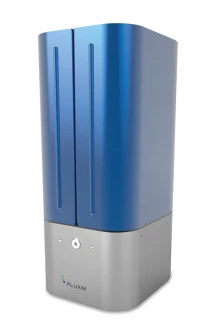Fluxim AG - Phelos - Gonio-Spectrometer for Angle-Dependent Electroluminescence and Photoluminescence Measurements
Description
Phelos is an angular luminescence spectrometer to characterize light-emitting devices and thin films over varied emission and polarization angles.While traditional goniometric instruments focus on either electroluminescence (EL) or photoluminescence (PL), Phelos incorporates both measuring techniques in one table-top compact instrument. The Phelos software can be easily coupled to the powerful simulation software Setfos for data analysis, parameter extraction, and device modeling.
Trusted by industry and academic researchers, Phelos measurements have substantially contributed to numerous scientific publications.
Customer Review
"Phelos angle-dependent photoluminescence (PL)/electroluminescence (EL) spectrometer along with Setfos package is a great combination of hardware and software to characterize the orientation of emission transition dipole moment. User-friendly interface and a broad range of parameters, such as polarization angles, position angles, driving current, and J-V parameters to investigate the PL as well as EL characteristics of light-emitting semiconductors. We have extensively used both Phelos and Setfos to understand the quantum emission characteristics of perovskites and organometallic complexes and light-extraction efficiency in PeLEDs and OLEDs. We found these tools allowed fast data acquisition, simulation, and in-depth understanding of emission characteristics of LEDs and OLEDs"
Dr. Sudhir Kumar, Nanomaterials Engineering Research Group, Institute for Chemical and Bioengineering, ETH Zürich
>>Watch the Phelos Video Here<<
Different Operation Modes
Phelos is a spectrometer for both Photoluminescence and Electroluminescence measurements. The instrument is equipped with an internal SMU that is used alternatively for the EL or PL characterization.
Electroluminescence
Measurement System For The Analysis Of The Electroluminescence Of An Organic Light-emitting Diode And A Perovskite Light-emitting Diode
- Analysis of the Color Efficiency.
- Viewing Angle.
- (EQE, lm/W, Cd/A)
- Fitting of the Emission Zone.
- Emitter Orientation.
Photoluminescence
Phelos can be used as a Photoluminescence Thin Film Characterization Instrument
- Angular Dependent Analysis of the light emission characteristics.
- Emitter orientation.
- Spectrum and Color per Emission Angle.
- Polarization in Light-Emitting Thin Films.
Down-Conversion and Scattering
- Characterization of the Scattering and Down-Conversion in Thin Films
- OLEDs functionalized with Quantum Dots
* Smaller spectral range with higher resolution available upon request.
** Default wavelength is 365 nm. Various excitation wavelengths optionally available
Fluxim AG - Phelos - Gonio-Spectrometer for Angle-Dependent Electroluminescence and Photoluminescence Measurements
Specifications |
|
|---|---|
| Spectrometer Type: | Not Specified |
| Wavelength Range: | 360 – 1100 nm |
| Angular Range : | -90° to +90°, top and bottom emission |
| PL Illumination Spot Size: | 5 x 3 mm2 |
| PL Excitation: | 275 nm to 405 nm ** |
| Sample Stage Size : | 40 x 40 mm2 |
| Motorized Polarizer : | 0 to 360° (continuous) |
| Minimal Resolvable Current : | < 100 pA |
| Current Range : | ± 120 mA |
| Voltage Range : | ± 20 V |
| Signal-to-noise Ratio : | 300:1 |
| Spectral Resolution: | 2.5 nm * |
| Signal-to-noise Ratio : | 300:1 |
| Computer Connection : | USB |
| Weight: | 18 kg |
| Dimensions : | 50 x 29 x 24 cm3 |
Features
Advantages of using Phelos
- Angular photoluminescence (PL) spectroscopy on organic, quantum-dot, and perovskite light-emitting thin films.
- Angular electroluminescence (EL) spectroscopy on OLEDs and other light-emitting devices.
- Angle dependence of the light emission of an OLED and other light-emitting devices.
- Compatible with top and bottom emitting OLED structures.
- Detection of p- and s-polarized signal, or continuous sweep over polarization angles.
- Determine where in your emission layer the dipoles are emitting, and which is the orientation of the dipoles.
- Integrated data analysis allows you to determine dipole orientation with one click.
- Easily coupled to Setfos for advanced parameter extraction and device modeling.
- Flexible contacting of any sample geometry and easy sample alignment.
- Acquire current-voltage-luminance (IVL) curves with the integrated SMU
- Measure: EQE, lm/W, Cd/A, CRI, and CIE coordinates
- Polarizers and macro-extraction lens included. Multiple light sources are available.
Applications
Phelos can be used for the development of:
- Organic LEDs
- Perovskite LEDs
- QD-Films for LCDs
- Micro-LEDs
For pricing, technical or any other questions please contact the supplier
- No registration required
- No markups, no fees
- Direct contact with supplier
-
Ships from:
Switzerland
-
Sold by:
-
On FindLight:
since 2022
Frequently Asked Questions
The Phelos spectrometer is used to characterize light-emitting devices and thin films over varied emission and polarization angles.
Yes, the Phelos spectrometer incorporates both electroluminescence and photoluminescence measuring techniques in one instrument.
Yes, the Phelos software can be easily coupled to the powerful simulation software Setfos for data analysis, parameter extraction, and device modeling.
The Phelos spectrometer can perform measurements such as analysis of electroluminescence, photoluminescence, color efficiency, viewing angle, fitting of the emission zone, emitter orientation, and spectrum and color per emission angle.
Some advantages of using the Phelos spectrometer include angular photoluminescence spectroscopy on organic, quantum-dot, and perovskite light-emitting thin films, angular electroluminescence spectroscopy on OLEDs and other light-emitting devices, and the ability to determine dipole orientation with integrated data analysis.


